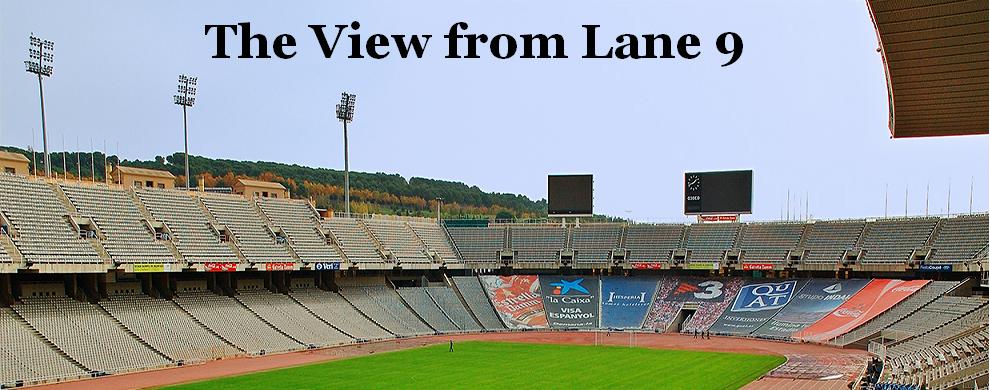 As people who read this blog or have talked to me about it well know, I'm all for livening up track and field with some new ideas. So, when NCAA coaches start hashing out ways to improve nationals and make it replicate the best aspects of the conference meets that precede it, I'm all ears. Arkansas' coach Chris Bucknam's proposal, however, is just a terrible, misguided idea. Texas A&M coach Pat Henry's 8 team meet proposal is even worse.
As people who read this blog or have talked to me about it well know, I'm all for livening up track and field with some new ideas. So, when NCAA coaches start hashing out ways to improve nationals and make it replicate the best aspects of the conference meets that precede it, I'm all ears. Arkansas' coach Chris Bucknam's proposal, however, is just a terrible, misguided idea. Texas A&M coach Pat Henry's 8 team meet proposal is even worse.First of all, attempting to make a sport more "fan-friendly" and popular by replicating the BCS is about as logical as trying to dry off with a fire hose. Fans universally hate the BCS as evidenced by the piece of artwork I've displayed here and the wide popularity of books like "Death to the BCS". Everyone hates a system that may exclude the best based on arbitrary, elitist arrangements. Universally, there is a belief that the best athletes on merit should be a part of the championship meet.
If we follow Bucknam's advice we would be shutting out a ton of great athletes from smaller schools, which would be unpopular as well as unfair. Football fans think it's ridiculous that TCU, for example, gets shut out of the National Championship game because of a system of computers and human opinion polls. Now, imagine 3:55 miler Miles Batty or 3:57 mile Erik Van Ingen getting shut out entirely of the national meet because they don't go to a big school. The field would be significantly watered down and ridded of some compelling standouts. Worse yet, in their place in Patrick Henry's system would be 4:05-4:10 milers, for example, from big-conference schools who were only there because of their team's superior field athletes and sprinters and vise versa. Who wants to see that? Bucknam and Henry mistakenly believe that the conference meets illustrate that American viewing audiences do.
While the American audience may love head-to-head matchups in true team sports like football and basketball, it's unclear whether that really transfers over to track except for perhaps in relays. As much as these coaches like to think that their conference meets make for fantastic viewing experiences for large audiences, the evidence reveals a different story. It's pretty telling that the TV coverage of major conference meets is delayed weeks, and when it is shown it is very limited in distribution. If the appeal of fierce team competition was so great, I'm sure wide audiences would have demanded live broadcasts of these conference meets. The truth is that these team battles appeal very strongly to former athletes of the teams, the coaches, and the participants. A broad viewing audience, though, has different tastes.
To put it frankly, anything but the highest caliber of track just isn't that popular among TV viewers whether there are team battles and fierce rivalries or not. A Michigan-Ohio State dual track meet won't get ratings anywhere near what a basketball game or football game between the two would. This apathy by casual sports fans and even avid track fans applies to competitions that don't show the best of the collegiate ranks. It also applies to the pro ranks. This year's indoor USA Championships meet had lackadaisical interest because most of the best athletes were absent. I don't see how leaving out great athletes who belong at the national meet for their individual accomplishments wouldn't hurt much more than it could possibly help in terms of drawing viewers. Restricting the number of teams so that there will be more familiar uniforms is not going to transform the meet into some television bonanza.
So, as much as these coaches would like to think otherwise, people tune into track not to see Arkansas miler #1 versus Florida miler #1 in the team hunt, but rather to see individual athletes and phenoms like German Fernandez and Kirani James. Cutting some of these appealing athletes from the field will without exception do more harm than good in attracting an audience. From a competitive standpoint, at the national championship the best should be on display, and not as in Henry's proposed 8 team meet, just some elitist mish-mash of deep teams with solid, but not necessarily national-caliber athletes. Bucknam's system overestimates the effect and participation of non-BCS schools who add more in interest (with intriguing athletes such as Maine's Riley Masters) than they add in unwieldiness due to the large number of them. If coaches want to add more team competitiveness and passion they should instead look to the events of the Championship to be more inclusive.
The team aspect of track and field that I actually think translates to wider appeal are relays. The indoor meet has two in the 4x400m and the Distance Medley, and here viewers get to see some fierce battles between teams. If coaches want to up the intensity of Nationals, I believe this is the correct place to start. Adding a 4x200m relay or a Sprint Medley would heighten the intensity and enhance team rivalries more than leaving worthy athletes out ever would. It also would allow for larger squads for some of the power track schools. This would help replicate the fervor and representation of a conference meet.
Now that might be something to replicate. The BCS? Not so much.

No comments:
Post a Comment